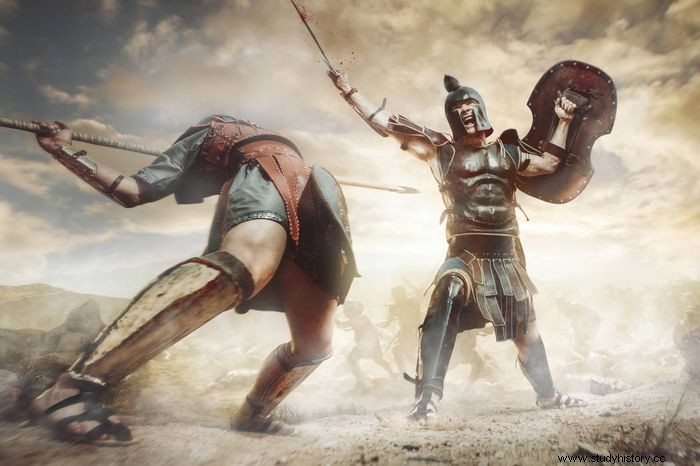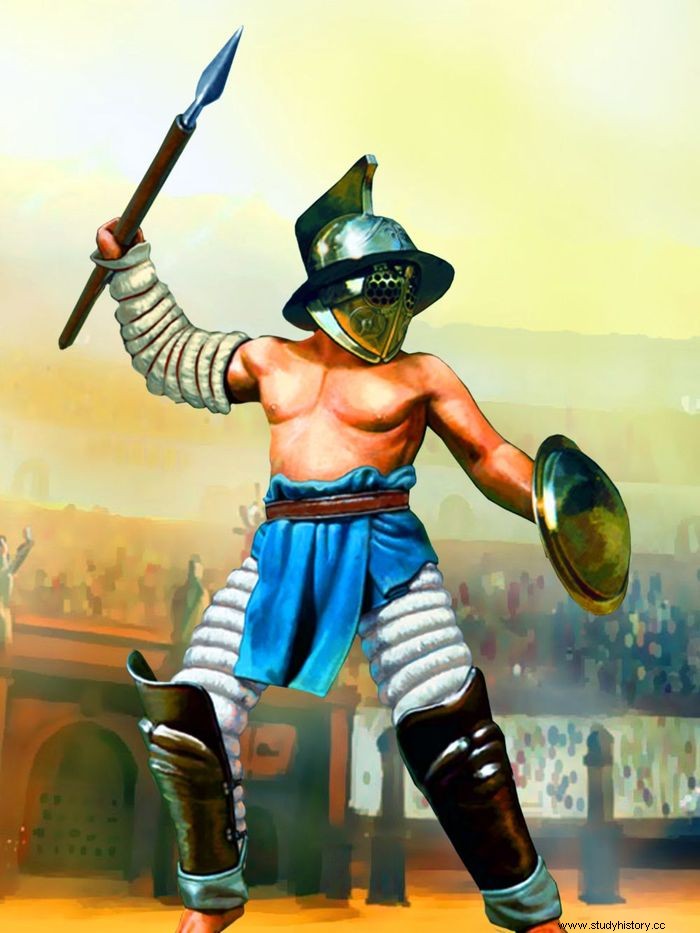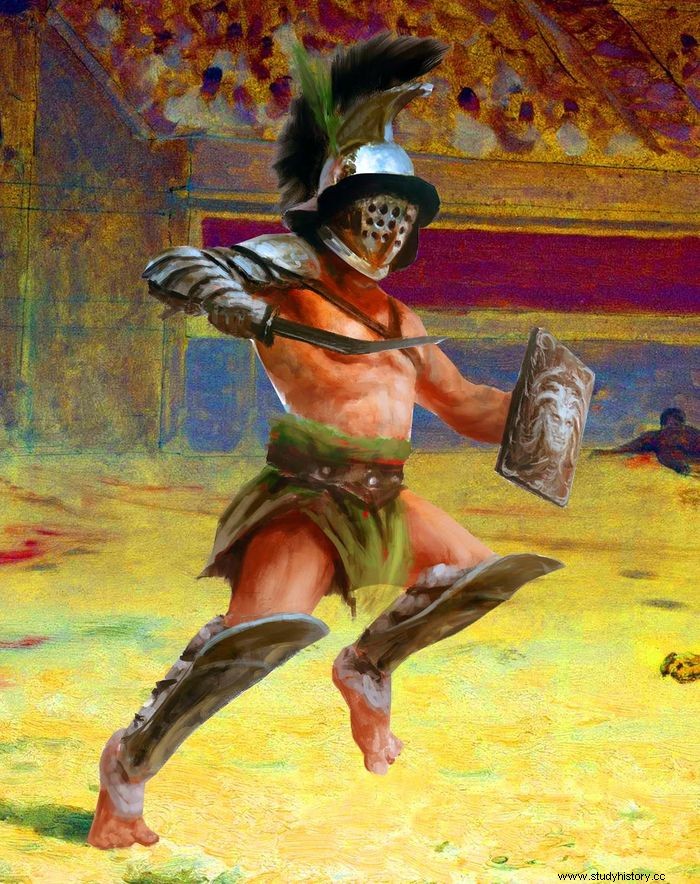After the destruction of Carthage in 201 BCE, Rome began two centuries of virtually uninterrupted imperial expansion. By the end of this period, Rome ruled over the entire Mediterranean basin and most of northern and western Europe. The empire's population, estimated at 50 to 60 million people, was about one-fifth or one-sixth of the world's population. Tens of thousands of conquered people paid taxes to the Roman state. In addition, slaves were taken into battle and taken to Italy. For the most part, Roman soldiers who served for long years and fought elsewhere bore the cost. Gladiator exhibitions converted war into a game, maintained a sense of peace in peacetime, and served as a political scene for clashes between rulers and rulers. The Gladiator Games lasted over a thousand years, reaching their peak between the first and second centuries BCE.
The Origins of Gladiator Games
Adoption of gladiatorial games took place from the older Etruscans, perhaps via Campania. They began sacrificial ceremonies because of the spirits of the dead and the need to appease them with blood sacrifices. They first appeared in Rome in 264 BC, when Junius Brutus' sons honored their father by pairing three pairs of gladiators. Munera were traditionally the necessary funeral victims because of aristocratic men at their death.
Julius Caesar, elected nobleman in 65 BC, honored his father, who had died twenty years earlier, with an exhibition of 320 pairs of gladiators in silver armor. An anxious Senate, still remembering Spartacus' uprising, reduced the number of gladiators allowed in Rome. In 46 BCE, after recent triumphs in Gaul and Egypt, Caesar threw magnificent events at the tomb of his daughter Julia, who had died in childbirth eight years before, which included the first sighting of a giraffe.
During the republic, the munera was financed privately by the family, whose responsibility was to present them. As the ritual became more a display of aristocratic riches and pride, it lost much of its religious value and became more explicitly political. Augustus delegated the games to the Pretors and limited the number of gladiatorial games to two per year and sixty pairs to limit this power. The emperors eventually adopted the Games as a decision of their sovereignty.
After Spartacus' slave revolt in 73 BCE, the state gained increasing control of public games, and many gladiators were educated in imperial colleges. Interestingly, the Latin word ludus means both "game" and "school", as both needed imitation and repetition. They would sell or rent a troop (familia) of gladiators under the supervision of a manager (lanista). Many were privately maintained as bodyguards by politicians and rich people, especially during periods of public unrest.
The Gladiator

Gladiators, named after the Roman sword known as gladius, were usually imprisoned criminals, prisoners of war, and slaves. Some gladiators were voluntary, usually liberated or extremely low levels of free-born men who chose to live as slaves for cash prizes or fame and excitement. Anyone who became a gladiator was inherently infamous, under the law, and therefore unfit to be a citizen. Although technically prohibited by law, a limited number of upper-class men participated in the gladiatorial games. Yet they did not live with the other gladiators and represented a distinct, esoteric type of entertainment, as did the extremely rare women who competed in the arena.
All gladiators took a formal oath (Sacramentum Gladiatorium), similar but far more terrible than the legionary's:"I will endure being burned, bound, beaten and murdered with the sword". Paradoxically, this terrible oath offered the gladiator a degree of will and even honor. Trained gladiators had a chance to survive, if not flourish. Some gladiators fought only two or three times a year, and the best of them became famous heroes. Skilled warriors can win a large sum of money, and the wooden sword (rudis) symbolizes their independence. Liberated gladiators can fight for money again, although they were more likely to become school coaches for gladiatorial games or freelance bodyguards for the wealthy.
Gladiators were classified into many groups based on the type of armor they wore, their weapons and their fighting style. However, most gladiators remained in one category, and battles often included two separate gladiator categories. The following examples show some of several types of gladiators identified by current scholars:
The Eques
Eques fought another gladiator of the same sort. Their fights most likely start on horseback, but they end in hand-to-hand combat. They were the only gladiators who fought in ordinary tunics instead of armor, although they wore bronze helmets with two feathers and padded leg protectors; they used round shields and often fought with long swords.
Hoplomachus (heavy weapon hunter)

Hoplomachus, named after the Greek hoplite warrior, fought with a long spear and a short sword or dagger in the gladiatorial games; he wore a parachute helmet and long greaves over both legs to protect them because he wore only a small shield, usually round in shape. A Hoplomachus fights a Thraex who tries to reach over his shield and stab him in this terracotta relief. A late Republican tombstone depicts a Thraex fighting a kneeling Hoplomachus, though both gladiators wear early styles of helmetless visors.
Murmillo (fish)
Murmilloen, named after a Greek saltwater fish, wore a helmet with a wide visor with a high comb; these helmets gradually grew adorned with relief ornaments, such as Hercules' head, military trophies and Gorgon, Mars Ultor and ornaments. Murmillo's left leg was covered by a broad, slightly curved, rectangular shield; thus he only needed a short leg protector (okrea). He used a short stabbing sword to fight (gladius). The wreaths on a tombstone in Ephesus suggest that Murmillo won many battles. In another Ephesus relief, Murmillo Asteropaios tries to stab Thraex Drakon on the left side.
The provocateur (attacker)
The provocateur ("attacker") was the most equipped gladiator, and he was the only gladiator wearing a breastplate that protected the visible upper part of the chest. He also had a padded armrest and a greave on his left leg, and he carried a wide rectangular shield and a stabbing sword. His wide, shielded helmet lacked an emblem and stretched over his shoulders. The provocateur's armor made him slower and less nimble than other gladiators, which may explain why he was usually a partner with another gladiator of the same kind in a battle.
The Retiarius (Netman)
Retiarius was the fastest and most mobile gladiator; as the only gladiator who did not wear a helmet, he had a significantly wider field of vision than his opponents. But because he had almost little protective armor, he was also more vulnerable to large wounds. His only body protection was a padded arm protector (manica) on his left arm, often topped with a high metal shoulder protector (galerus). His weapons included a large net to wrap the opponent, a long wooden fork and a small knife. In this relief, a Retiarius moves towards a Secutor who has lost his shield.
The Securer (The Pursuer)
The secretary ("the pursuer") was usually a partner of a Retiarius. His egg-shaped helmet with spherical eye holes had no comb or reliefs to catch on Retiarius' net, which limited his field of vision. He wore a short leg guard (ocrea) and an arm guard on one leg, and he used a wide rectangular shield and a stabbing sword. The wreaths of this Secutor monument represent his numerous triumphs, while in this relief a jubilant Secutor called Improbus prepares to execute a fallen Retiarius.
Thraex (Thracian)

The Thraex gladiator was formed after the Thracians, Rome's former opponents. His most characteristic feature was his weapon, a short sword (sica) with a bent or kinked blade. His visor with a wide brim resembled a Murmillo, but on top of it was a griffin head. Thraexen had arm protection and long leg guards (ocreae) on both legs since he wore a small rectangular shield. These have theatrical masks and an eagle vs snake theme.
The Bestiarius (Animal-fighter)
Bestiarius was a gladiator who received training in handling and fighting various animals. The bestiaries were the lowest ranked gladiators; they were not as famous or popular as other gladiators.
Gladiator Training for Gladiator Games
A lanista was the leader of a gladiatorial company; he provided extensive and hard training in schools (ludi) specially designed for this purpose and usually located near the large amphitheaters. Pompeii, for example, had a modest training ground near the theater surrounded by a gladiator barracks and a huge training ground (palaestra) right near the theater. The emperor had direct oversight of all gladiatorial schools in Rome during the imperial period. The largest of these institutions, Ludus Magnus, was built near the Colosseum. It has a practice amphitheater, the remains of which can be seen today.
Gladiator Arena
Gladiator games, such as carriage races, were originally held in wide open spaces with temporary seating. Implementation of some munera took place in the Roman Forum. But as games became more common and popular, the demand became a larger and more permanent structure. Although the use of the Circus Maximus was frequent due to its large seating capacity, the Romans eventually designed a building specifically for this spectacle known as an amphitheater. In the harena, the seat extended around the oval or elliptical performance range.
Early amphitheater construction took place with wood, both in Rome and elsewhere. Stone amphitheaters, however, proved to be far more durable. The construction of the earliest stone amphitheater took place in Pompeii in the first century AD. and could accommodate around 20,000 XNUMX people. Moreover, like Roman theaters, amphitheaters were free-standing structures, enabling construction anywhere since they did not require natural hills, as Greek theater did.
The Colosseum

Staging of gladiatorial games took place in Rome in the Colosseum, a massive stadium opened in 80 AD. The Colosseum, located in the heart of the city, was round in design with three layers of arches around the perimeter. The structure was as tall as a current 12-story skyscraper and could accommodate 50,000 XNUMX people.
The Colosseum, like many modern professional sports stadiums, included box seats for the wealthy and powerful. The top floor was too ordinary. The floor of the Colosseum was a maze of halls, corridors and cages that stored weapons while animals and gladiators waited their turn to shop.
The Colosseum now shows no indication of the magnificent decoration that once adorned this amphitheater. They included colorfully painted sculptures, ornate marble and painted stucco. Instead, we can see the clutter of underground structures, corridors, ramps, animal enclosures, and prison chambers.
Before a Gladiatorial Game Day
Marketing of gladiatorial games happened a lot in advance, with signs indicating the purpose of the event. The promotions also include the editor, place, date and number of paired gladiators (ordinarii). Highlighting details about venues, executions, music and other pleasures for spectators, such as an awning against the sun, water sprinkles, food, drinks, sweets and sometimes "door prizes", also happened. On Munus Day, a more thorough program (libellus) was given. They indicate names, types and matches of gladiator pairs and their order of appearance. The gladiators happened to have a meal and the opportunity to order their personal and private matters last night.
On a gladiatorial game day
Gladiator games begin with an elaborate parade with participants led by the editor. The editor was generally the emperor of Rome during the imperial period, and a high-ranking judge in the provinces. Music was often played through the procession and associated activities. This morning's negotiations can start with fake fights like this. After these, there will be animal exhibitions, which include animals that do feats, but most often hunt (venationes). In venationes, more exotic creatures were pitted against each other or hunted and killed by bestiarii.
During the lunch break, executions of criminals who commit horrific crimes such as murder, arson and blasphemy take place. The public aspect of the execution made it both degrading and unpleasant. It was meant to act as a deterrent to others. Damnatio ad bestias was a type of arena execution. The condemned were sent into the arena with vicious beasts or forced to participate in "dramatic" re-enactments of epic events in which the "stars" really died. It also happened to force criminals to fight in the arena without prior preparation. Death was a sure conclusion in such battles because the "victim" had to face several opponents until he died.
Individual gladiator fights were the highlight of the afternoon events. These were often battles between gladiators wearing different armor and fighting techniques. The matches were monitored by a referee with a long stick (summa rudis). Although a broad assumption is that these battles begin with the gladiators exclaiming, "Those who are going to die greet you," the only evidence for this statement is seen in Claudius' description of a naumachia involving convicts.
Victory or defeat in a gladiator game
There were several rituals in the arena. For example, when a gladiator incurs damage and wants to accept defeat, he will lift his index finger. The crowd would then signal whether they wanted the defeated gladiator killed or spared. The widespread belief is that "thumbs down" indicates killing and "thumbs up" means reserve. However, there is no visual evidence for this, and the textual evidence shows that pollicem vertere ("turning the thumb") meant killing and pollicem premere ("pressing the thumb") meant reserve. This action may mean that those who wanted the gladiator murdered waved their thumbs in all directions. Those who wanted him saved placed their thumbs against their hands. In any scenario, the game's sponsor decides whether to give the defeated gladiator a respite (mission). At the same time, killing the gladiator demanded that he receive the fatal blow without shouting or giving way.
The conclusion
Gladiator fighting began as part of the burials of powerful Romans who had died. Emperors hosted these massive gladiatorial games for funerals of high-ranking Roman officials. The link between gladiatorial games and funerals has faded over time. For the most part, the upper class arranged the games primarily to increase their social prestige and gain the favor of the population. Many politicians used these well-known games to influence power and popularity polls.
